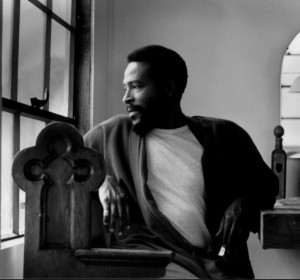 Where did all the blue skies go?
Where did all the blue skies go?
Poison is the wind that blows from the north and south and east…
Oil wasted on the ocean and upon our seas
Fish full of mercury…
Radiation under ground and in the sky
Animals and birds who live nearby are dying…
How about this overcrowded land
How much more abuse from man can she stand?
“Mercy Mercy Me” is no doubt the first and perhaps the only Top 40 hit to address the sad state of the environment. It was the second single released from “What’s Going On,” Marvin’s groundbreaking 1971 concept/protest album that confronted issues like injustice, the Vietnam War, police brutality, poverty, and other social ills.
In 1991 Motown Records released this moving “Mercy Mercy Me” video, seven years after Marvin was shot and killed by his father during a domestic dispute. Numerous celebrities appear throughout the video to show their support for environmental protection. Marvin’s message resonates now as much as ever, in these days of fracking, oil spills, and carbon dioxide emissions.
© Dana Spiardi, April 22, 2015
]]>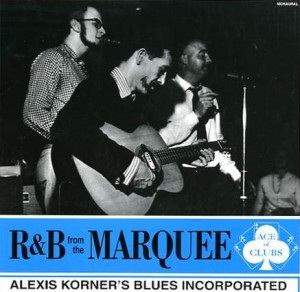 Disciples of the band and its blues style included future high priests of rock — Eric Clapton, Jeff Beck, John Mayall of Bluesbreakers fame, future Yardbird/Led Zeppelin guitarist Jimmy Page, Rod Stewart, The Who, and Eric Burden of the Animals — many of whom occasionally took part in early Blues Incorporated sessions at the famous Ealing Jazz Club during “Rhythm and Blues Nights.” It was at this club on April 7, 1962, that Alexis Korner introduced Mick Jagger and Keith Richards to blues fanatic Brian Jones, thus spawning The Rolling Stones.
Disciples of the band and its blues style included future high priests of rock — Eric Clapton, Jeff Beck, John Mayall of Bluesbreakers fame, future Yardbird/Led Zeppelin guitarist Jimmy Page, Rod Stewart, The Who, and Eric Burden of the Animals — many of whom occasionally took part in early Blues Incorporated sessions at the famous Ealing Jazz Club during “Rhythm and Blues Nights.” It was at this club on April 7, 1962, that Alexis Korner introduced Mick Jagger and Keith Richards to blues fanatic Brian Jones, thus spawning The Rolling Stones.
The son of an Austrian Jewish father and a Turkish-Greek mother, Korner spent his youth in France, Switzerland, and North Africa. In 1940 the family settled permanently in London, where young Alexis played blues records during German air raids. He met fellow blues purist Cyril Davies in 1949 in Chris Barber’s Jazz Band and in 1955 the two formed the London Blues and Barrelhouse Club. Korner invited leading American blues artists to the club, introducing Great Britain to a style of music that was virtually unknown outside of the United States.
Korner continued to perform long after the 1966 breakup of Blues Incorporated, and also worked as a radio personality and contributing writer for many years. His disciples went on to become rock superstars, their names far better known than his, but among true aficionados of electric blues, Alexis will always be considered its founding father.
Here’s Alexis Korner in 1975, performing with former Small Faces frontman, the late, great Steve Marriott. The bluesman died on January 1, 1984.
By Dana Spiardi, Jan 1, 2013
]]>
 Ol’ Sly Stone sure fell into the category of different folks, alright. He was never destined to live among the ranks of everyday people. He was one outrageous, mega-talented dude. Nobody on the planet had a funkier, chunkier Afro than Sly. That ‘Fro simply knew no bounds, extending into sideburns that should have been called wideburns. Sly shared honors with Jimi Hendrix for best dressed ’60s ebony God. But while Jimi personified the gypsy as hippie with his bright paisley prints and ruffly shirts, Sly was the true sartorial spaceman in knee boots, satin, and studded leather. He had ATTITUDE.
Ol’ Sly Stone sure fell into the category of different folks, alright. He was never destined to live among the ranks of everyday people. He was one outrageous, mega-talented dude. Nobody on the planet had a funkier, chunkier Afro than Sly. That ‘Fro simply knew no bounds, extending into sideburns that should have been called wideburns. Sly shared honors with Jimi Hendrix for best dressed ’60s ebony God. But while Jimi personified the gypsy as hippie with his bright paisley prints and ruffly shirts, Sly was the true sartorial spaceman in knee boots, satin, and studded leather. He had ATTITUDE.
Sly took James Brown’s innovative sound to a new level, pioneering a style and persona that influenced all the funk stars that followed, from George Clinton and Rick James to Prince and Michael Jackson. Where do you think the term funkadelic came from, anyway? It emerged from Sly’s blending of funk rhythms with psychedelic rock – with Stax soul, gospel and Motown pop thrown into the caldron to keep things interesting.
Born Sylvester Stewart on March 15, 1944, Sly was raised in a deeply religious family in Vallejo, California. As young teens, he and siblings Freddie, Rose, and Vaetta released a 78rpm single, “On the Battlefield of the Lord,” as the Four Stewarts. Sly spent a few years as a DJ on San Francisco radio station KSOL, then went on to form his first band, Sly and the Stoners. Meanwhile, Sly’s brother Freddie was fronting his own group, Freddie and the Stone Souls. The two bands merged in December 1966 to form Sly and the Family Stone, with Sly on organ, vocals and a variety of other instruments, Freddie on lead guitar, Larry Graham on bass, Cynthia Robinson on trumpet, and white boys Gregg Errico on drums and Jerry Martini on saxophone. A year later, Stone sister Rose joined the lineup as vocalist and keyboardist. Sly recruited a high school gospel group, which featured Sly’s sister Vaetta, to provide background vocals. He named them Little Sister.
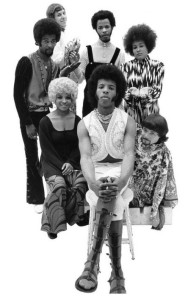 Sly and the Family Stone was revolutionary at the time, not just for the unusual racial mix, but because the group’s women weren’t merely there to provide eye candy, backing vocals, or dance moves. They played instruments and had a presence all their own. Cynthia Robinson became known for her impromptu shout-outs: “All the squares go home!” On songs such as “Dance to the Music,” various band members took turns singing lead on each verse, an uncommon style at the time. Larry Graham’s distinctive “slapping” bass guitar technique became a signature element that defined all funk music that followed.
Sly and the Family Stone was revolutionary at the time, not just for the unusual racial mix, but because the group’s women weren’t merely there to provide eye candy, backing vocals, or dance moves. They played instruments and had a presence all their own. Cynthia Robinson became known for her impromptu shout-outs: “All the squares go home!” On songs such as “Dance to the Music,” various band members took turns singing lead on each verse, an uncommon style at the time. Larry Graham’s distinctive “slapping” bass guitar technique became a signature element that defined all funk music that followed.
They churned out a string of great singles: “Everyday People,” “Thank You (Falettinme Be Mice Elf Agin),” “Everybody Is a Star,” “Hot Fun in the Summertime,” “Family Affair,” and “I Want to Take You Higher.” Their songs discouraged hate and discrimination and encouraged peace, understanding, self-respect and simple, shameless fun. The band made a huge splash at Woodstock and appeared on mainstream TV programs like the Mike Douglas Show and Dick Cavett. I can still remember the hype surrounding Sly’s 1974 in-concert wedding extravaganza at Madison Square Garden. The bizarre PR stunt was chronicled in a New Yorker article, satirically titled “The Biggest Event This Year.”
But like most artists of that era, the band’s members fell prey to heavy drugs. Internal bickering lead to a frequently changing lineup of musicians. Sy was under pressure from the Black Panthers to replace the two white musicians, Errico and Martini, with “brothers.” The band’s record company, Epic, was demanding a higher output of marketable material.
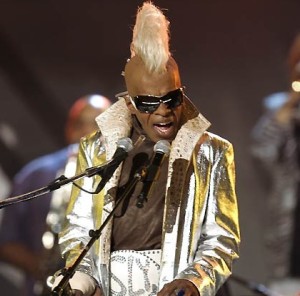 Sly forged ahead into the 1970s, but soon succumbed to near-paralyzing drug addiction, often missing gigs or just refusing to play. His spending sprees, paranoia and outlandish behavior were legendary. When the Family Stone was inducted into the Rock and Roll Hall of Fame in 1993, Sly was nowhere to be found – right up till the minute his fellow members walked to the podium to accept the award. Then, he suddenly appeared, mumbled a few words (“See you soon”) and vanished. For the past 25 years he’s been one of the music world’s most notorious “whatever happened to…?” personalities. He appeared briefly – sporting a blonde mohawk and wearing a silver lamé suit and sunglasses – for a Sly and the Family Stone tribute at the 2006 Grammy Awards, but ended up abandoning his bandmates by leaving the stage during a performance of “I Want to Take You Higher.” Several years later he attempted a comeback of sorts, when he released “I’m Back! Family & Friends” in 2011. It was his first album since 1982’s “Ain’t But the One Way,” and featured such guests as Jeff Beck, Ray Manzarek, Ann Wilson, Johnny Winter.
Sly forged ahead into the 1970s, but soon succumbed to near-paralyzing drug addiction, often missing gigs or just refusing to play. His spending sprees, paranoia and outlandish behavior were legendary. When the Family Stone was inducted into the Rock and Roll Hall of Fame in 1993, Sly was nowhere to be found – right up till the minute his fellow members walked to the podium to accept the award. Then, he suddenly appeared, mumbled a few words (“See you soon”) and vanished. For the past 25 years he’s been one of the music world’s most notorious “whatever happened to…?” personalities. He appeared briefly – sporting a blonde mohawk and wearing a silver lamé suit and sunglasses – for a Sly and the Family Stone tribute at the 2006 Grammy Awards, but ended up abandoning his bandmates by leaving the stage during a performance of “I Want to Take You Higher.” Several years later he attempted a comeback of sorts, when he released “I’m Back! Family & Friends” in 2011. It was his first album since 1982’s “Ain’t But the One Way,” and featured such guests as Jeff Beck, Ray Manzarek, Ann Wilson, Johnny Winter.
A few years back, while channel surfing, I heard a TV announcer say, “Coming up next: Sly Stone – nearly homeless!” Well, I just had to stay tuned. It turns out that Sly has evolved into a broken down man. He lives in an old white van in a rundown area of LA, and makes music on a laptop computer. He runs an electrical line from his mobile home to a friend’s nearby house, where he goes to take showers. In an August 2013 interview with Alexis Petridis of The Guardian, Sly’s road manager Neal Austinson said the mercurial singer is fairly healthy, and “for the most part” clean of drugs. He says Sly “likes to smoke a little weed and maybe have a cocktail before he gets onstage, but he’s 70 years old, he can’t do what he used to do, no one can at that age. And you know, coke is a very expensive habit to maintain.”
But within the past week, Sly suddenly became $5 million richer, after an L.A. jury found Sly’s former manager and entertainment attorney guilty of diverting royalties that were owed to him over the past 20 years. Now, let’s just hope the cash doesn’t go up his nose.
Best of luck to you, Sly, on your 72nd birthday. You burned out fast, but when it came to funkadelic rock and soul, you did it first and you did it best. And, with your wild multi-colored band of guys and girls, you were rock’s first equal opportunity employer.
Here’s the original Family Stone lineup on Soul Train.
By Dana Spiardi, March 15, 2015
]]>Lots of Diddley-based tunes are obvious, like “Willy and the Hand Jive” and Bo’s own “Who Do You Love?” But you may not realize just how many songs have been fueled by that distinctive beat. No rocker can resist it! Here’s a collection of my favorite Bo Babies. Turn your speakers up loud and go crazy, man, crazy!
Here’s the original, from the master himself, born Ellas Otha Bates on December 30, 1928. He entered rock heaven on June 2, 2008. Hundreds paid tribute to him upon his passing: from the U.S. President and House of Representative members, to countless rock and R&B giants. The University of Florida posthumously awarded Bo a Doctor of Fine Arts degree, and a Voice of America radio service declared that “his influence was so widespread that it is hard to imagine what rock and roll would have sounded like without him.”
Buddy Holly wrote and recorded “Not Fade Away,” but there’s absolutely no doubt that The Stones produced the definitive version. Here’s young Mick, shakin’ his money-maker on The Mike Douglas show in 1964. And the late, great Brian Jones plays a mean blues harp.
Here’s my favorite Who song, “Magic Bus.” Betcha didn’t realize this was born of Bo!
Check out this great clip of Bruce honoring Bo with his Diddley-inspired “She’s the One.
Even punk rockers loved Bo. Here’s The Clash, performing one of my favorites, “Rudie Can’t Fail.” For the record, the word “rudie” comes from Jamaican street culture, and quite literally refers to rude (bad) boys. Brit punks of the 1970s quickly co-opted the name!
The Irish know a good beat when they hear one. “Mystic Eyes,” by Northern Ireland’s Them, is a raucous Diddley-based R&B number. Van Morrison wrote it, and belts it out here in this 1965 performance. Have you ever seen Van this young?
From Belfast to Dublin, here’s U2 with “Desire.” You can count on Bono for descriptive lyrics: She’s the dollars; she’s my protection. Yeah she’s a promise in the year of election. Oh sister, I can’t let you go. Like a preacher stealing hearts at a traveling show.
David Bowie’s “Panic in Detroit” is one of my favorite Diddley-inspired numbers:
Here’s a metal version of Bo’s beat from Guns N’Roses: “Mr. Brownstone.” Slash, you do Bo proud!
Oh, Chrissie…how do I love thee? Let me count the ways. Here’s the queen of the Pretenders with “Break up the Concrete.”
We’ll end with Bo in 1989, making some heavy thunder with his trademark rectangular guitar.
Now, doesn’t this trip down Bo Boulevard just make your ENTIRE day? If these rhythms don’t inspire you to move your feet, shake your hips, bop your head, or – at the very least – tap your fingers, then honey, methinks you’re dead.
© Dana Spiardi, March 2, 2013
]]>
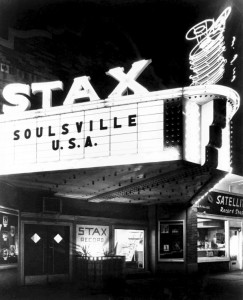 After operating for several years in Brunswick, Tennessee, Stewart moved the operation back to Memphis — into the former Capitol Theatre, located in a predominantly black neighborhood. This ushered in the start of a whole lotta sensational soul music. Stewart forged a friendship with DJ and singer Rufus Thomas, who, together with his daughter Carla, recorded Satellite’s first regional hit, “Cause I Love You.”
After operating for several years in Brunswick, Tennessee, Stewart moved the operation back to Memphis — into the former Capitol Theatre, located in a predominantly black neighborhood. This ushered in the start of a whole lotta sensational soul music. Stewart forged a friendship with DJ and singer Rufus Thomas, who, together with his daughter Carla, recorded Satellite’s first regional hit, “Cause I Love You.”
Upon learning of a California-based company with the same name, Stewart and Axton renamed their label Stax, a combination of their names. In 1965, Stewart signed a national distribution deal with Atlantic Records, and the hits kept coming.
Thanks to the unusual layout of the studio (the sloping floor of the one-time movie theater contributed to the distinctive Stax sound), the brilliance of A&R man Steve Cropper, and the talent of the studio’s house band – the racially integrated Booker T. and the M.G.s – Stax Records would go on to become a premiere recording studio specializing in soul, R&B, funk, jazz, and gospel music.
 And what did Estelle contribute to the scene? Plenty. Despite her lack of musical training, she had a keen ear and helped choose and develop the label’s artists. She provided inspiration, advice, and encouragement to writers and artists, and demonstrated shrewd marketing sense. She also ran the well-stocked Stax record shop, which became a popular hangout and offered employment opportunities for local youths. Stax artists and staff members affectionately addressed her as “Miz Axton” or “Lady A.”
And what did Estelle contribute to the scene? Plenty. Despite her lack of musical training, she had a keen ear and helped choose and develop the label’s artists. She provided inspiration, advice, and encouragement to writers and artists, and demonstrated shrewd marketing sense. She also ran the well-stocked Stax record shop, which became a popular hangout and offered employment opportunities for local youths. Stax artists and staff members affectionately addressed her as “Miz Axton” or “Lady A.”
Said Booker T. Jones: “She just loved music, loved people. She was always bringing us up there [the record shop], having us listen to records. She kept us in touch with the music industry. I doubt there would have been a Stax Records without Estelle Axton. She encouraged the entire Stax roster from her little perch behind the counter.”
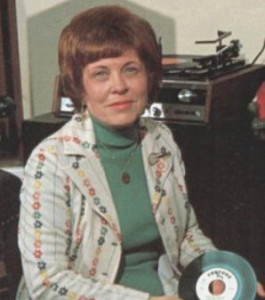 Estelle sold her interest in Stax in 1970 and later formed Fretone Records, which released Rick Dees’ 1976 novelty song “Disco Duck” (later released by RSO Records). She went on to establish the Memphis Songwriters Association, which fostered the education and advancement of local area songwriters. And, along with her friend Cordell Jackson, she founded the Music Industries of Memphis (later named the Memphis Music Association) to maintain and promote her city’s role as a musical mecca.
Estelle sold her interest in Stax in 1970 and later formed Fretone Records, which released Rick Dees’ 1976 novelty song “Disco Duck” (later released by RSO Records). She went on to establish the Memphis Songwriters Association, which fostered the education and advancement of local area songwriters. And, along with her friend Cordell Jackson, she founded the Music Industries of Memphis (later named the Memphis Music Association) to maintain and promote her city’s role as a musical mecca.
Estelle Stewart Axton died on February 24, 2004, at the age of 85. She has the distinction of being the first woman to establish a major record company, paving the way for future woman-owned labels like Olivia Records, Wise Woman/Urana, Pleiades, Righteous Babe Records, and Redwood Records. Thank you, Lady A.
Here’s part one of the documentary “Respect Yourself: The Story of Stax Records,” which describes Estelle’s role in the legendary record company.
© Dana Spiardi, Feb 24, 2014
]]>